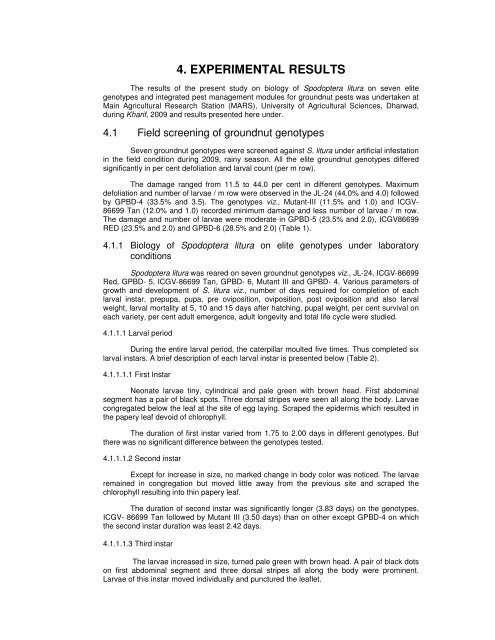screening elite genotypes and ipm of defoliators in groundnut
screening elite genotypes and ipm of defoliators in groundnut
screening elite genotypes and ipm of defoliators in groundnut
You also want an ePaper? Increase the reach of your titles
YUMPU automatically turns print PDFs into web optimized ePapers that Google loves.
4. EXPERIMENTAL RESULTS<br />
The results <strong>of</strong> the present study on biology <strong>of</strong> Spodoptera litura on seven <strong>elite</strong><br />
<strong>genotypes</strong> <strong>and</strong> <strong>in</strong>tegrated pest management modules for <strong>groundnut</strong> pests was undertaken at<br />
Ma<strong>in</strong> Agricultural Research Station (MARS), University <strong>of</strong> Agricultural Sciences, Dharwad,<br />
dur<strong>in</strong>g Kharif, 2009 <strong>and</strong> results presented here under.<br />
4.1 Field <strong>screen<strong>in</strong>g</strong> <strong>of</strong> <strong>groundnut</strong> <strong>genotypes</strong><br />
Seven <strong>groundnut</strong> <strong>genotypes</strong> were screened aga<strong>in</strong>st S. litura under artificial <strong>in</strong>festation<br />
<strong>in</strong> the field condition dur<strong>in</strong>g 2009, ra<strong>in</strong>y season. All the <strong>elite</strong> <strong>groundnut</strong> <strong>genotypes</strong> differed<br />
significantly <strong>in</strong> per cent defoliation <strong>and</strong> larval count (per m row).<br />
The damage ranged from 11.5 to 44.0 per cent <strong>in</strong> different <strong>genotypes</strong>. Maximum<br />
defoliation <strong>and</strong> number <strong>of</strong> larvae / m row were observed <strong>in</strong> the JL-24 (44.0% <strong>and</strong> 4.0) followed<br />
by GPBD-4 (33.5% <strong>and</strong> 3.5). The <strong>genotypes</strong> viz., Mutant-III (11.5% <strong>and</strong> 1.0) <strong>and</strong> ICGV-<br />
86699 Tan (12.0% <strong>and</strong> 1.0) recorded m<strong>in</strong>imum damage <strong>and</strong> less number <strong>of</strong> larvae / m row.<br />
The damage <strong>and</strong> number <strong>of</strong> larvae were moderate <strong>in</strong> GPBD-5 (23.5% <strong>and</strong> 2.0), ICGV86699<br />
RED (23.5% <strong>and</strong> 2.0) <strong>and</strong> GPBD-6 (28.5% <strong>and</strong> 2.0) (Table 1).<br />
4.1.1 Biology <strong>of</strong> Spodoptera litura on <strong>elite</strong> <strong>genotypes</strong> under laboratory<br />
conditions<br />
Spodoptera litura was reared on seven <strong>groundnut</strong> <strong>genotypes</strong> viz., JL-24, ICGV-86699<br />
Red, GPBD- 5, ICGV-86699 Tan, GPBD- 6, Mutant III <strong>and</strong> GPBD- 4. Various parameters <strong>of</strong><br />
growth <strong>and</strong> development <strong>of</strong> S. litura viz., number <strong>of</strong> days required for completion <strong>of</strong> each<br />
larval <strong>in</strong>star, prepupa, pupa, pre oviposition, oviposition, post oviposition <strong>and</strong> also larval<br />
weight, larval mortality at 5, 10 <strong>and</strong> 15 days after hatch<strong>in</strong>g, pupal weight, per cent survival on<br />
each variety, per cent adult emergence, adult longevity <strong>and</strong> total life cycle were studied.<br />
4.1.1.1 Larval period<br />
Dur<strong>in</strong>g the entire larval period, the caterpillar moulted five times. Thus completed six<br />
larval <strong>in</strong>stars. A brief description <strong>of</strong> each larval <strong>in</strong>star is presented below (Table 2).<br />
4.1.1.1.1 First Instar<br />
Neonate larvae t<strong>in</strong>y, cyl<strong>in</strong>drical <strong>and</strong> pale green with brown head. First abdom<strong>in</strong>al<br />
segment has a pair <strong>of</strong> black spots. Three dorsal stripes were seen all along the body. Larvae<br />
congregated below the leaf at the site <strong>of</strong> egg lay<strong>in</strong>g. Scraped the epidermis which resulted <strong>in</strong><br />
the papery leaf devoid <strong>of</strong> chlorophyll.<br />
The duration <strong>of</strong> first <strong>in</strong>star varied from 1.75 to 2.00 days <strong>in</strong> different <strong>genotypes</strong>. But<br />
there was no significant difference between the <strong>genotypes</strong> tested.<br />
4.1.1.1.2 Second <strong>in</strong>star<br />
Except for <strong>in</strong>crease <strong>in</strong> size, no marked change <strong>in</strong> body color was noticed. The larvae<br />
rema<strong>in</strong>ed <strong>in</strong> congregation but moved little away from the previous site <strong>and</strong> scraped the<br />
chlorophyll result<strong>in</strong>g <strong>in</strong>to th<strong>in</strong> papery leaf.<br />
The duration <strong>of</strong> second <strong>in</strong>star was significantly longer (3.83 days) on the <strong>genotypes</strong>,<br />
ICGV- 86699 Tan followed by Mutant III (3.50 days) than on other except GPBD-4 on which<br />
the second <strong>in</strong>star duration was least 2.42 days.<br />
4.1.1.1.3 Third <strong>in</strong>star<br />
The larvae <strong>in</strong>creased <strong>in</strong> size, turned pale green with brown head. A pair <strong>of</strong> black dots<br />
on first abdom<strong>in</strong>al segment <strong>and</strong> three dorsal stripes all along the body were prom<strong>in</strong>ent.<br />
Larvae <strong>of</strong> this <strong>in</strong>star moved <strong>in</strong>dividually <strong>and</strong> punctured the leaflet.
















